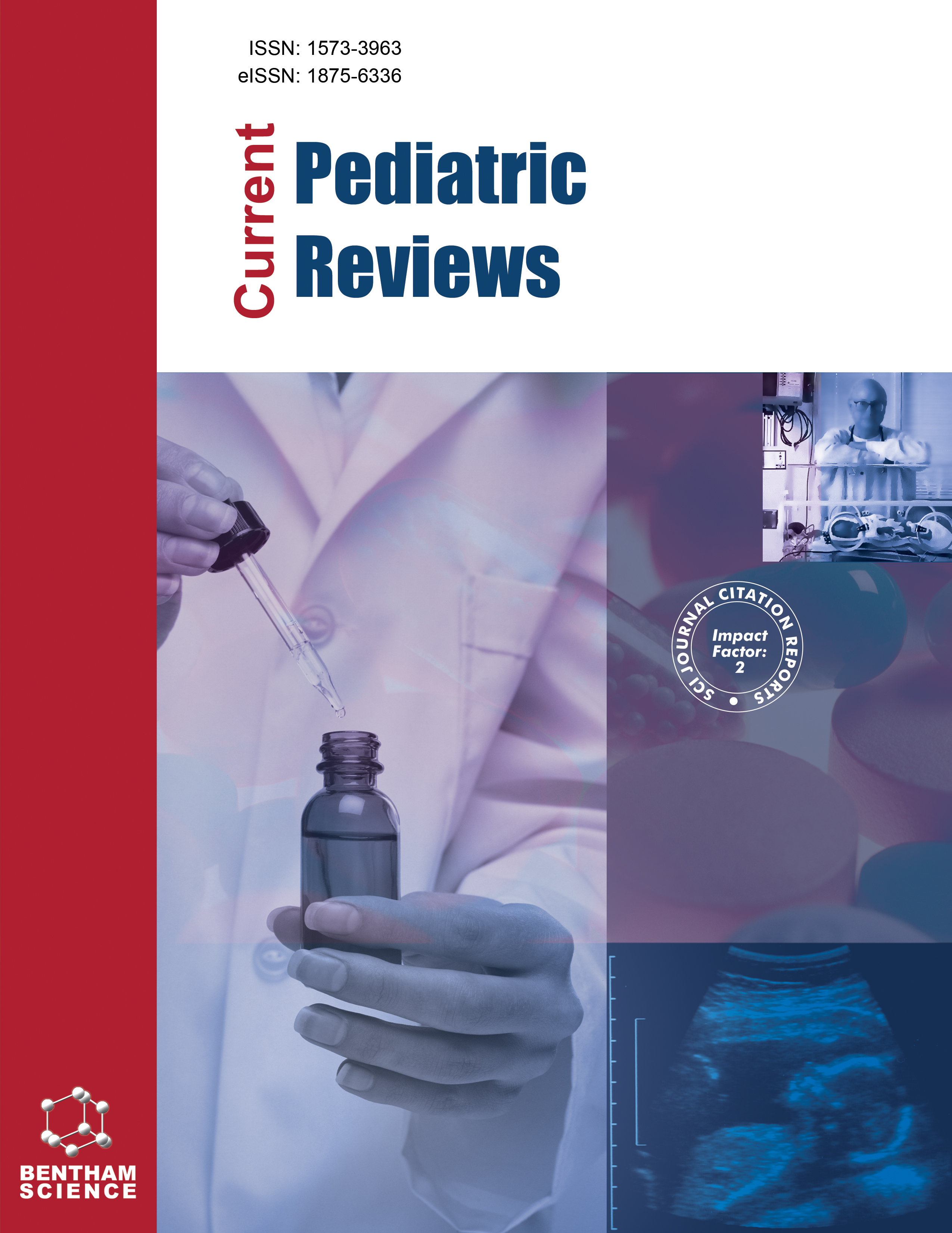- Home
- A-Z Publications
- Current Pediatric Reviews
- Previous Issues
- Volume 4, Issue 1, 2008
Current Pediatric Reviews - Volume 4, Issue 1, 2008
Volume 4, Issue 1, 2008
-
-
Editorial
More LessBronchopulmonary dysplasia (BPD) is a common adverse outcome of premature birth, affecting approximately 40% of those born prior to 29 weeks of gestation. It has long term adverse consequences including recurrent respiratory symptoms requiring treatment and lung function abnormalities at school age and adolescence. In this issue, Drs. Davis and Sweet highlight that BPD is caused by a combination of insults on the develo Read More
-
-
-
Pathophysiology and Prevention of Bronchopulmonary Dysplasia
More LessAuthors: Jonathan W. Davis and David G. SweetBPD is the major respiratory complication of preterm delivery and is typified by chronic oxygen dependency and respiratory insufficiency beyond 36 weeks' postconceptional age. It is caused by a combination of insults on the developing lung precipitated by preterm birth and its subsequent respiratory management. The common pathway linking the various causative factors is inflammation, which may be initiated prior to bir Read More
-
-
-
Congenital Duodenal Obstruction: The Impact of Down's Syndrome in Neonatal Morbidity. A Two-Center Survey
More LessBackground/Purpose: Babies with congenital duodenal obstruction (CDO) have a high incidence of additional anomalies. Down's syndrome (DS) is the most common associated chromosomal defect, affecting up to 20% of these newborns. Morbidity is expected to be higher in DS patients, since it is a major cause of congenital heart disease, immunodeficiency, and other birth defects. We could find only one report concerning the Read More
-
-
-
A Comprehensive Update on Congenital Glaucoma
More LessAuthors: Deepak P. Edward, Thasarat S. Vajaranant, Sami Al-Shahwan and Bassem A. BejjaniCongenital glaucoma is a broad group of disorders that present with elevated intraocular pressure in children. Pediatricians and family physicians have significant roles in diagnosing the condition in its early stages. The disorder is infrequent but can be a sight threatening condition or even life threatening when associated with certain systemic conditions. The reported incidence of the condition is variable and more prevalent in Read More
-
-
-
Sudden Infant Death Syndrome: A Review of the Literature
More LessAuthors: Olanrewaju O. Omojokun and Rachel Y. MoonSudden Infant Death Syndrome (SIDS) is characterized by the sudden death of an infant, unexpected by history and unexplained by a postmortem exam. The rate of SIDS has decreased markedly since the launch of the Back to Sleep campaign and other public health initiatives. Despite these efforts, SIDS remains the third leading cause of infant death and the leading cause of postneonatal deaths in the United States. The cau Read More
-
-
-
The Fragile X Family of Disorders: A Model for Autism and Targeted Treatments
More LessAuthors: Randi J. Hagerman, Susan M. Rivera and Paul J. HagermanCGG-repeat expansion mutations of the fragile X mental retardation 1 (FMR1) gene are the leading known cause of autism and autism spectrum disorders (ASD). Full mutation expansions (>200 CGG repeats) of the gene are generally silenced, resulting in absence of the FMR1 protein and fragile X syndrome. By contrast, smaller expansions in the premutation range (55-200 CGG repeats) result in excess gene activity and R Read More
-
-
-
Early Communication Skills; Important in Screening for Language Impairment and Neuropsychiatric Disorders
More LessAuthors: Barbro Bruce and Kristina HanssonCommunication skills during social interaction at 18 months' age, such as comprehension of instructions and play behaviour, have been shown to predict the results on language tests three years later. Accordingly, children with weak communication skills are at risk for persistent problems of language and communication. Problems of communication in social interaction are also common in children with neuropsychiatric disor Read More
-
-
-
New Insights into the Pathogenesis of and Long-Term Risks in Children with Henoch-Schonlein Purpura Nephritis
More LessAuthors: Lavjay Butani and Keith K. LauRenal involvement is the major factor determining the long-term outcome of children with Henoch-Schonlein Purpura (HSP) nephritis. The precise incidence of adverse outcomes is debatable; moreover, there are conflicting data on the validity of prognostic factors for predicting adverse outcome in children with HSP nephritis. Difficulties in prognostication are compounded by lack of non-invasive diagnostic methods in chil Read More
-
Volumes & issues
-
Volume 21 (2025)
-
Volume 20 (2024)
-
Volume 19 (2023)
-
Volume 18 (2022)
-
Volume 17 (2021)
-
Volume 16 (2020)
-
Volume 15 (2019)
-
Volume 14 (2018)
-
Volume 13 (2017)
-
Volume 12 (2016)
-
Volume 11 (2015)
-
Volume 10 (2014)
-
Volume 9 (2013)
-
Volume 8 (2012)
-
Volume 7 (2011)
-
Volume 6 (2010)
-
Volume 5 (2009)
-
Volume 4 (2008)
-
Volume 3 (2007)
-
Volume 2 (2006)
-
Volume 1 (2005)
Most Read This Month
Article
content/journals/cpr
Journal
10
5
false
en


